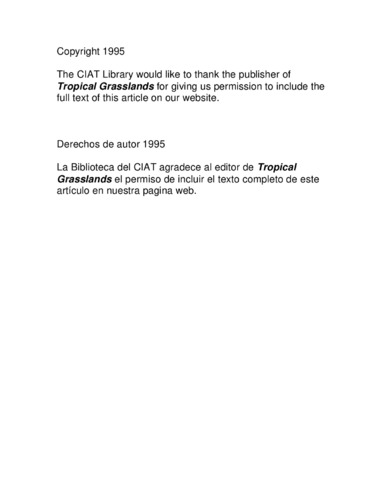Dry season performance of four tropical pasture legumes in subhumid west Africa as influenced by superphosphate application and weed control
The productivity and nutritive value of Chamaecrista rotundifolia cv. Wynn, Centrosema pascuorum cv. Cavalcade, Stylosanthes guianensis cv. Pucallpa and S. hamata cv. Verano as affected by single superphosphate fertilisation (SSP) and weed control were measured during the dry season in subhumid Nigeria. Wynn, when growing in competition with the native vegetation, had the highest dry matter yields. During the dry season, legume yields were more stable than those of the associated grasses and herbs. Fertilisation with SSP at low levels of available soil phosphorus increased legume productivity but native grasses and herbs did not respond to the fertiliser applied.
The nutritive value of all legume species was low for most of the dry season, with crude protein concentrations, in vitro dry matter digestibility, and phosphorus concentrations ranging between 5–7%, 40–50% and 0.02–0.05%, respectively. The decline of nutritive value during the dry season was largely a function of changes in leaf/stem/litter proportions. It is suggested that drought tolerance and capacity to retain leaf should receive more attention when evaluating forage species to be used in the dry season. Despite these limitations, Wynn has potential to complement the widely used Stylosanthes hamata cv. Verano in drier subhumid west Africa. The other species tested could be successfully used in legume mixtures.
Despite these limitations, Wynn has potential to complement the widely used Stylosanthes hamata cv. Verano in drier subhumid west Africa. The other species tested could be successfully used in legume mixtures.

